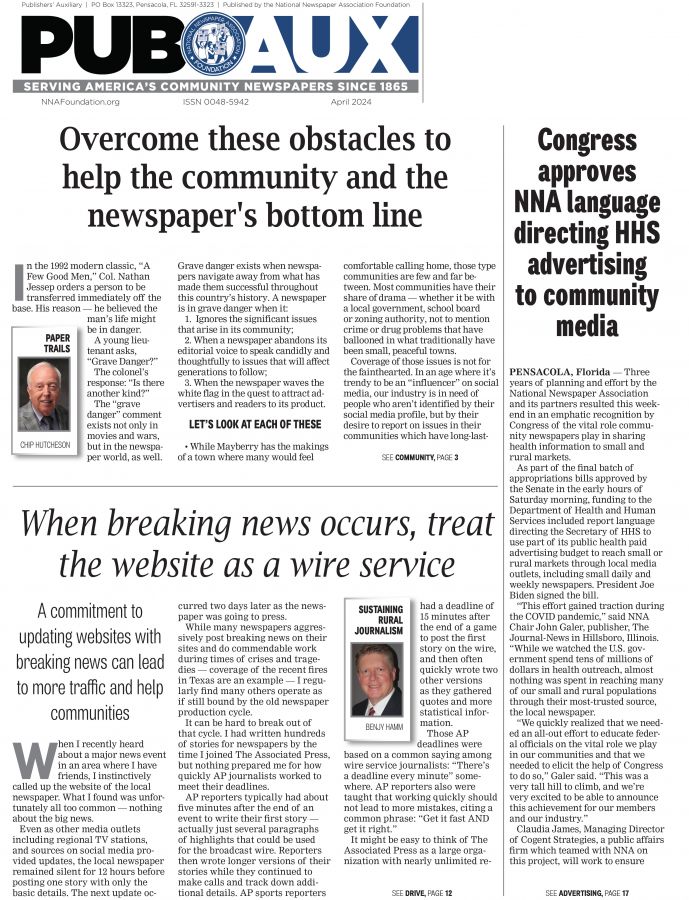Daily newspapers aren’t just a victim of the times
Feb 1, 2013
BY MIKE BUFFINGTON
Co-Publisher | MainStreet Newspapers, Jefferson GA
The recent story on “60 Minutes” about the New Orleans Times Picayune having gone to a three-day per week print publication schedule brought a lot of attention to the problems facing the daily newspaper industry.
But what that national story didn’t do was highlight the fact that many daily newspapers are struggling not just because of the economy and Internet, but also because of their own lack of flexibility in adapting to a changing environment. Daily newspapers aren’t just victims of the times, as some commentators suggest.
A quick review of how daily newspapers got into this mess is in order. From 1982 to 2005, the U.S. saw massive economic growth. Although there were downturns, overall the economy was stable and dynamic. Jobs were created, housing boomed and consumer demand was strong.
In addition, this was the era when cheap personal computers revolutionized newspaper production by bringing greater efficiency to what had been a plodding process of getting the elements of a newspaper (news, advertising and photos) into print. Consumer computers also cost much less than the costlier vertical systems newspapers used for production.
The twin effects of a growing economy and greater efficiency created large profits for many daily newspapers and asset values soared. That led to an increasing pace of consolidation as newspaper groups bought more and more newspaper properties.
But because of the debt created by all of that consolidation, when the 2008 recession hit, large newspaper groups of dailies were especially vulnerable. The pressure of all that debt forced many newspapers to make massive cuts in order for their parent corporation to make bank payments. Although these newspapers were often profitable, they didn’t generate the kind of net dollars needed to service all the corporate debt.
Making this even worse was the effect that corporatization had on local newspaper management decision-making. By 2008, many daily newspapers were being run by publishers who thought more like corporate bean-counting accountants than traditional ink-stained newspaper publishers. That led to many misguided cuts that weakened the paper’s core product and readership. Wire copy invaded what had been local news holes; it was cheaper, but when readership declined, these publishers couldn’t understand why. And even today, many daily newspapers continue to fill up their front pages with stories that their readers get for free from Yahoo or Google, or any number of other online sources. Falling readership has taught many newspaper corporations nothing about what local readers expect from their local newspaper.
Adding to daily newspaper woes has been the impact of the Internet. Although new technology had initially helped the industry with efficiency, Internet technology was a killer. Classified advertising, which had been the prime profit center for daily newspapers, fled to online. Real estate and automotive advertising also went away because of the recession and because they had also become Internet-based to a large extent.
All of that was a difficult challenge, but making it worse was the response by many corporate daily managers. In a bid to compete, they began to give away their content online for free, thinking that such a model would eventually be supported by migrating advertising to online. It hasn’t worked out that way. There’s simply not enough online revenue to sustain real local news gathering in most communities.
Magnifying that, however, was that publishers simultaneously shredded their print rate cards by adopting a “let’s make a deal” attitude. Daily publishers got the idea that “getting something was better than getting nothing,” so they began selling ROP and preprints for whatever an advertiser was willing to pay, even if that was below actual production costs. Quick cash flow, not common sense, became the standard advertising sales business model at many daily newspapers.
But that cheapened the print product even more in the eyes of advertisers, who quickly saw that rate cards had become meaningless. In order to get short-term cash, daily publishers are giving away their long-term financial health.
So the real story in all of this isn’t that New Orleans and a few other daily newspapers have dropped their print editions to less than daily, but rather it’s this question: Why haven’t more daily newspapers done the same thing? With websites to fill in the gap, it makes little financial sense to continue publishing a print edition every day in communities where a newspaper is losing money.
So why isn’t the Time Picayune three-day model more common?
Two reasons. First is the idea prevalent among many daily publishers that anything less than daily isn’t a “real” newspaper. Those of us who publish weekly community newspapers have seen this attitude for decades, the condescending view that what weeklies do just isn’t “serious” journalism. Many daily publishers just can’t imagine a business model other than what they’ve always known, which is to print on a daily basis. They have no frame of reference for any other way of thinking about print.
The other reason many daily publishers and corporate owners hesitate to cut print frequency is that they’ve waited late in the game to try. Had they done that earlier and integrated print with online strategically, the transition would have been easier. Now, however, they’ve spoiled readers with free online content, spoiled advertisers with cheap ROP rates and teed off readers with a declining local news hole. They dug themselves into a pretty deep hole.
Nowhere has this downward spiral been felt more acutely than at smaller regional daily newspapers. These papers are neither fish nor fowl—their markets are too small to generate the kind of online revenues of the larger metro papers, but they’ve still got huge fixed costs of daily publication and distribution. More than the major metro newspapers that have some deep pockets, dailies in small markets are facing a huge crisis.
Despite that trend and the gloomy tone of that “60 Minutes” report, the newspaper industry overall isn’t dead. Out in the hinterlands where weeklies and two- and three-day newspapers operate, the business has been much quicker to adapt. For many non-daily newspapers, the Internet has been a boon by leveling the playing field with daily newspapers in breaking news and it helps keep the non-daily newspapers in the game. And non-daily newspapers don’t have the baggage of daily printing and distribution expenses and have been more financially able to absorb the economic blows.
No doubt the Times Picayune’s move to less than daily print has been controversial, especially in New Orleans where the community views the move as somehow unbefitting the city. Don’t all “important” cities have a daily newspaper?
That’s a misplaced attitude, but one that also exists deep within the executive suites of many large newspaper corporations. Inside their boardrooms, publishers wring their hands when they consider less than daily printing—they feel as if they’re lowering themselves to some kind of substandard existence if they don’t print every day of the week.
But from the vantage point of a weekly newspaper publisher, the frequency of publication has nothing to do with producing “real journalism.” To think otherwise is a psychological barrier that comes from the corporate ego of daily publishers, not from the true economic realities the industry faces.
After all, isn’t it better to have a financially sustainable newspaper printing three days a week than a financially weak daily that both readers and advertisers know is slowly limping toward its own demise?
mike@mainstreetnews.com.







